Advertisement
Ingredient-Based Cookbooklets
Appears in
Published 2004
In many cases, the advertised food products were simply the old generic commodities with new brand names. Because brand-name products required advertising and expensive packaging, they cost more than generic products. Manufacturers had to offer reasons why housewives should purchase their products rather than generic products. Hence, the “new and improved” shibboleth became commonly associated with food advertising campaigns. In addition, many products claimed health benefits.
Many food products, however, were new creations or inventions and had no generic equivalent. In these cases manufacturers had to create a demand for their products. Also, housewives had to be shown how to use these products. As these were showcase recipes, they were often developed by professionals. Two successful early examples include the Shredded Wheat Company and the Genesee Pure Food Company. The Shredded Wheat Company produced a series of advertising cookbooklets provocatively titled The Vital Question (1899), featuring dozens of creative uses for shredded wheat; the Genesee Pure Food Company published cookbooklets that included a wide variety of recipes incorporating Jell-O.


